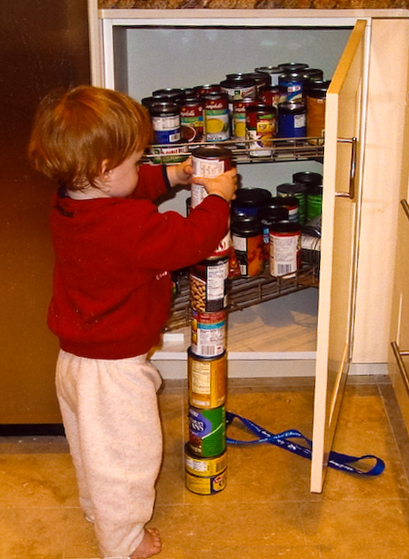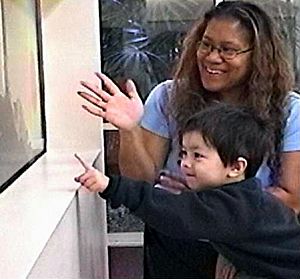Autism facts for kids
Quick facts for kids Autism spectrum |
|
|---|---|
| Synonyms | Autism, autism spectrum condition (ASC), autism spectrum disorder (ASD) |
 |
|
| Repetitively stacking or lining up objects is a common trait associated with autism. | |
| Symptoms | Difficulties in social interaction, verbal and nonverbal communication, and the presence of repetitive behavior or restricted interests |
| Complications | Social isolation, educational and employment problems, anxiety, stress, bullying, self-harm |
| Usual onset | Early childhood |
| Duration | Lifelong |
| Causes | Multi-factorial, with many uncertain factors |
| Risk factors | Family history, certain genetic conditions, having older parents, certain prescribed drugs, perinatal and neonatal health issues |
| Diagnostic method | Based on combination of clinical observation of behavior and development and comprehensive diagnostic testing completed by a team of qualified professionals (including clinical psychologists, neuropsychologists, pediatricians, and speech-language pathologists) |
| Similar conditions | Intellectual disability, anxiety, bipolar disorder, depression, Rett syndrome, attention deficit hyperactivity disorder, schizoid personality disorder, selective mutism, schizophrenia, obsessive compulsive disorder, social phobia, Einstein syndrome, PTSD, learning disorders (mainly speech disorders), social anxiety |
| Frequency |
|
The autism spectrum is a natural way some people's brains work. It is also called autism or autism spectrum disorder (ASD). People with autism often think and learn in different ways. They might find it hard to understand social rules. They may also communicate differently. Sometimes, they have strong interests in certain topics. They might also do things like repeat movements.
Autism is different for everyone. Some autistic people do not use spoken words. Others can speak very well. The amount of help people need can also vary a lot. The same person might act differently at different times.
Many autistic people and researchers see autism as part of neurodiversity. This means human brains are naturally diverse. It includes different ways of thinking and experiencing the world. This view suggests autism is not a sickness. However, it does not mean autistic people cannot have challenges or need support.
In the United States, about 1 in 68 children are diagnosed with ASD by age 8. Signs of autism usually appear between ages 2 and 4.
Contents
What Causes Autism?
Scientists are still learning what causes autism. It seems to be mostly genetic. This means it runs in families. Many different genes are involved. Things in the environment might also play a part.
Sometimes, autism happens with other conditions. These can include ADHD or epilepsy. Experts are still trying to understand why this happens.
More people are being diagnosed with autism today. This is because we know more about it. Also, the ways to diagnose it have become wider. This has led to a wrong idea that autism is spreading quickly. It has also kept alive a false idea that vaccines cause autism. This is not true.
Autistic people stay autistic throughout their lives. But different types of help can make a big difference. For example, some people learn new ways to communicate. Others might change their surroundings to feel more comfortable.
Signs and Characteristics
For many autistic people, signs usually appear when they are babies or young children. These signs often stay the same over time.
Doctors might check for ASD if a person shows:
- Regular difficulties with social interaction or communication.
- Behaviors that are repeated or interests that are very specific. These are often called "stimming".
- Trouble with changes or very focused interests.
Doctors look at these signs carefully. They also consider other things like:
- Problems finding or keeping a job or going to school.
- Difficulties starting or keeping friendships.
- Past experiences with mental health or learning support.
- A history of conditions like ADHD.
There are many signs linked to ASD. How they show up is very different for each person:
| Common signs for autistic spectrum disorder |
|---|
|
Unusual eating habits are also common. But they are not needed for a diagnosis.
Some autistic people have amazing skills. For example, in math, music, or art. In rare cases, this is called savant syndrome. More generally, autistic people often have a "spiky skills profile." This means they are very good at some things. But they might find other things much harder.
How Autism Develops
Autism can develop in two main ways. One way is gradual. Signs appear early in life and continue. The second way is when a child develops normally at first. Then, they might lose some skills. This is called regressive autism.
Social and Communication Skills
Autistic people may find it hard to make, keep, and understand relationships. They might also struggle to change their behavior for different social places. It is common for autistic people to talk a lot about a special interest. They might speak like they are giving a lesson. This can make it hard for others to join the conversation.
What looks like not caring about others is often a struggle. It can be hard to remember that other people have their own thoughts and interests. Another difference is that autistic people might not know when to speak softly. For example, they might talk loudly in a library or movie theater.
Autistic people might use nonverbal communication differently. Or they might have trouble with it. They may not make much eye contact. An autistic child might not look at someone when their name is called. They might also avoid looking at people.
Autistic people can struggle with showing and understanding facial expressions. They might not know how to read emotions from others' faces. Or they might not show the right facial expressions. It can be hard for them to understand small signs of emotion. They might not know what different emotions mean in a conversation.
A key feature is that autistic people have social differences. They often lack the natural understanding of others that many people have. They struggle to understand the hidden meanings in conversations or written text. This can make it hard to figure out what is really being said. This also leads to less social awareness. Their language might also be expressed in unusual ways.
Support and Help
As of 2022, there is no "cure" for autism. No known treatments can change the brain differences caused by autism. But many types of support can help children with autism. No single treatment is best. Support is usually planned for each child's specific needs.
The main goals of support are to lessen challenges. They also aim to reduce stress for families. And to improve a person's quality of life. They also help people become more independent. Generally, people with higher IQs tend to respond better to support.
Behavioral, psychological, and educational support can help. Skill-building activities can also assist autistic people. These help them learn life skills for living on their own. They also help with social, communication, and language skills. Support also aims to reduce challenging behaviors. And it helps build on a person's strengths.
Intensive, ongoing special education and behavior therapy early in life can help children. They can learn self-care, language, and job skills. Medicines do not help with the main signs of autism. But they can be used for other related issues. These include being easily annoyed, not paying attention, or repetitive behaviors.
Education
Educational support often includes applied behavior analysis (ABA). Other methods are developmental models and structured teaching. Speech and language therapy and social skills therapy are also used. Some of these methods help with all autistic features. Others focus on one specific area that needs help.
Work and Jobs
In the United States, about half of autistic people in their 20s do not have jobs. One third of those with college degrees might also be unemployed. As of 2021, more big companies in the United States are starting programs to hire autistic people. The most well-known program is "Autism at Work." It has grown to include 20 of the largest companies.
However, these special hiring programs are often for entry-level tech jobs. These include things like software testing. This means people with other talents might be left out. Another way is to include neurodiversity in all company systems. Making work systems flexible and fair helps all employees. This also improves the work experience for autistic employees.
Autism in Society
An autistic culture has grown. This includes the autistic rights and neurodiversity movements. These groups believe autism should be accepted as a difference. They argue it should be supported, not "cured." However, a few autistic people still look for a cure.
Around the world, there are events related to autism. These include World Autism Awareness Day and Autistic Pride Day. Many autistic people have been very successful in their fields.
Broader Autism Traits
The broader autism phenotype (BAP) describes people who do not have ASD. But they do show some autistic traits. These can include avoiding eye contact or stimming.
See also
 In Spanish: Trastornos del espectro autista para niños
In Spanish: Trastornos del espectro autista para niños
- Autism spectrum disorders in the media
- Extraordinary Attorney Woo
- List of films about autism
- Social narrative




